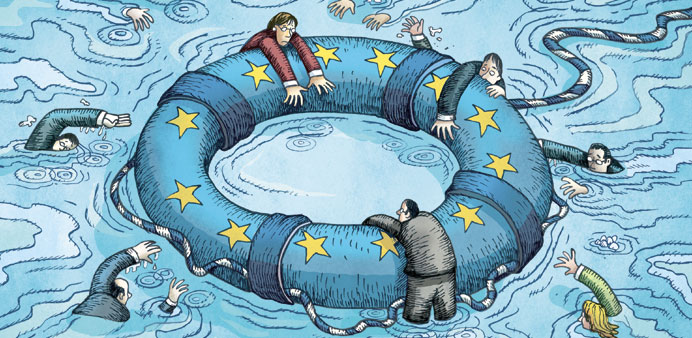By Paul De Grauwe/London
Since the 1970’s, economists have warned that a monetary union could not be sustained without a fiscal union. But the eurozone’s leaders have not heeded their advice – and the consequences are becoming increasingly apparent.
Europe now faces a difficult choice: either fix this fundamental design flaw and move toward fiscal union, or abandon the common currency.
Choosing the latter option would have devastating consequences. Indeed, while the desirability of establishing a monetary union may have been open to question in the 1990’s, dismantling the eurozone now would trigger profound economic, social, and political upheaval throughout Europe.
To avoid this outcome, Europe’s leaders must begin designing and implementing strategies aimed at bringing the eurozone closer to a fiscal union.
To be sure, a fiscal union such as that in the United States is a distant prospect that eurozone leaders should not expect to achieve any time soon – or even in their lifetimes. But that does not mean that establishing a fiscal union is a chimera. Small steps in the right direction now can make a significant difference.
A successful strategy would have to address one of the eurozone’s main design flaws: member governments issue debt in euros, a currency that they cannot control. As a result, they cannot provide a guarantee to bondholders that the cash will be available to pay them at maturity.
The mistrust and fear that this elicits in the bond markets can lead to liquidity crises that, creating a self-fulfilling prophecy, drive countries closer to default. They are then forced to implement austerity programmes that lead to deep recessions and, ultimately, to banking crises.
While austerity measures are appropriate in countries that have overspent in the past, the austerity that panic-stricken financial markets force upon a country can trigger a major social and political backlash. In fact, several southern European countries – such as Greece, Italy, Portugal and Spain – are currently experiencing exactly that.
To overcome this fundamental design flaw, government debts must be pooled. This would protect the weakest economies from destructive, panic-fuelled movements in financial markets, which, in theory, can hit any member country – even those that are strongest today.
In developing a strategy for pooling government debt, Europe’s leaders must address the possibility of moral hazard (the temptation for weaker countries to relax their debt- and deficit-reduction efforts in response to the increased credibility conferred by stronger countries).
Indeed, given stronger economies’ unwillingness to be exploited in this way, the risk of moral hazard is the most significant obstacle to pooling debts in the eurozone.
But it is not the only obstacle. A debt-pooling scheme must also address the fact that the strongest countries will inevitably face higher interest rates on their own debts when they become jointly liable for the debts of less credit-worthy governments.
To overcome these obstacles, a eurozone debt-mutualisation scheme must satisfy three crucial requirements.
First, the share of government debt that can be pooled must be strictly limited, leaving each country responsible for a significant portion of its national debt, and therefore motivated to maintain sound public finances. (Several initiatives have aimed to achieve this, notably Jakob von Weizsäcker and Jacques Delpla’s 2010 Blue Bond proposal.)
Second, an internal transfer mechanism between eurozone member states is needed in order to ensure that less credit-worthy countries compensate, at least partly, their more economically sound counterparts.
Finally, a supervisory authority must be established to monitor governments’ progress toward achieving sustainable debt levels – and to create clear consequences for those that break the eurozone’s budgetary rules.
The Padoa-Schioppa group recently proposed that rule-breaking governments should gradually lose control over their own national budgetary processes.
Opponents of debt mutualisation, especially in northern Europe, often argue that, in the absence of political unification, it amounts to putting the cart before the horse.
But what other measures could be taken to bring the eurozone closer to a political union? Military force – so often used in the past to unite diverse nations under a single political umbrella – is out of the question.
And simply waiting will have no effect. The only practical approach is to take small, sequential steps, starting with debt pooling.
In fact, Alexander Hamilton adopted this approach more than 200 years ago, when he decided to mutualise the debts that individual US states had incurred during the Revolutionary War – a decisive move toward further political integration.
Rather than wait for political union to happen, Hamilton took action that eventually helped the US to become a full-fledged monetary, fiscal and political union.
The eurozone is gripped by an existential crisis that is slowly, but inexorably, destroying the monetary union’s very foundations. The only way to stem the erosion is to take determined action that convinces financial markets that the eurozone is here to stay.
A debt-pooling scheme that satisfies the requirements outlined here would signal that the eurozone member countries are serious about sticking together.
Without this gesture, further market turmoil is inevitable – and the eurozone’s collapse will become only a matter of time.-Project Syndicate
* Paul De Grauwe is head of the European Institute at the London School of Economics.

